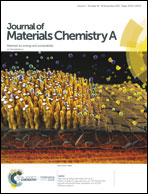Flexible, transparent ion-conducting membranes from two-dimensional nanoclays of intrinsic conductivity†
Abstract
The recent boom in human–machine interaction has triggered a significant demand for flexible and transparent ionotronics. State-of-the-art ion conductors are built by embedding electrolytes in a transparent gel polymer to form an ion-conducting composite, named ion conductive hydrogels or ionogels. Herein, we demonstrate an intrinsic ion-conducting membrane with ultrahigh ion conductivity, flexibility and transparency based on two-dimensional nanoclays of intrinsic conductivity (NICs). The inherently charged and ordered laminar microstructure exhibits an ultrahigh ion conductivity of 0.45 S cm−1 at 80 °C without external electrolytes, which is 100–1000 times higher than that of state-of-the-art ion-conducting composites. The NICs membranes also exhibit superior stability against harsh conditions including organic solvents, high temperature and prolonged dehydration–hydration cycles. We further demonstrate a NICs touch panel that can realize real-time, human–machine communication by drawing and typing. The nanoclays with intrinsic conductivity may open an avenue to electrolyte-free transparent and flexible ionotronics.



 Please wait while we load your content...
Please wait while we load your content...